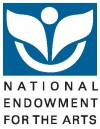AFRICAN MASKS
Some of the greatest museums of the world display collections of beautiful African masks. They have been admired by such famous European artists as Picasso and Braque. A number of art books have been devoted to the traditional masks of Africa. African masks are justly admired for their beauty and imaginative power. They are also folk art, true expressions of the spirit of the people for whom they were made.
African masks were created to be worn in tribal religious ceremonies, usually ritualistic dances. They represented animal gods and monsters familiar in the myths of particular tribes. The dance or ritual pageant acted out the legend.
The very creation of masks had religious overtones. The wood-carver practiced intense mediation and concentration when producing a mask, often retiring to a secluded hut in order to create the work. Some tribes stored masks in scared areas when not in use.
In the Caldwell collection there are several examples of African masks. Two in particular are the AFRICAN SUN MASK and the AFRICAN WINGED MASK (reference the Caldwell Collection pages). However, religious masks are certainly not confined to Africa. Similar masks are carved on Pacific islands. Masks are used in religious dances of Southeast Asia. Monster masks are still worn in dances performed in the Alpine villages of Switzerland and Austria. Masks serve the function of symbolically turning a dancer into a legendary figure. Though of all the masks of the world’s cultures, some of the finest have been created in Africa.
MATERIALS NEEDED:
Balloon, papier mache (newspaper strips dipped in wheat paste or diluted Elmer’s glue. Wheat paste or a flour and water mixture are preferable), tempera paint, bowl, brushes.
METHOD:
1. First have your students research several photographic examples of African masks, then let them design their own. Maybe they could combine the features they saw on several different masks, or completely create a new image.
2. Blow up the balloon to about the size of a human head and secure the end. Having torn newspaper sheets into no more than 1″ width strips, dip the strips in the glue mixture and carefully layer them across the balloon. Wrap only one half of the balloon, leaving the back side open. Continue this process until there are at least three good, thick layers on the balloon. Let dry. This may take more than a day’s time, depending on the thickness of the glue application.
*For the classroom, a clothesline may be strung, and the ends of the balloons clipped to the line. Remember to put paper underneath for dripping glue.
3. After completely dry, pop the balloon, and remove it from the back of the mask.
4. Trim, and/or sand the edges to decrease the roughness. Masking tape can even be used along the back edge to secure the paper layers together after trimming. Lay it long ways, along the edges, keeping it from intruding on the face area.
5. Cut out the eyes, if you intend to wear the mask.
6. Paint the desired images and colors on the mask. If the paint is somewhat thin, paint a coat of white over the entire mask first, which will help hide any print on the paper.
7. Optional–shellac the mask after painting. This brings out the colors and gives it an appealing sheen to the face.
Masks may also be made from paper sacks, scraps pieces of paper, pie plates, etc. Even old throw away items or things from nature which can be adhered easily may may be glued to the surface of the mask.
Come to the West TN Regional Art Center and experience the variety of ethnographic works of art in the Caldwell Collection.


